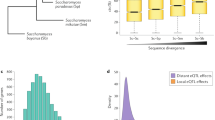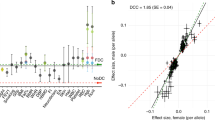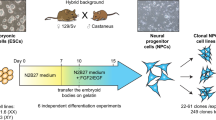Key Points
-
Monoallelic expression is an interesting epigenetic phenomenon, as it requires cells to treat the two alleles of a gene unequally, even though their sequences can be identical and they are present in the same nucleus.
-
Although monoallelic expression in the context of genomic imprinting is governed by marks placed during gametogenesis, for random monoallelic expression the determination of which allele will be expressed must be made by individual cells in the developing embryo. After a choice has been made, descendent cells maintain the choice.
-
It has been known for decades that the entire X chromosome in the cells of female placental mammals is subject to random monoallelic expression, but until recently autosomal examples were thought to be restricted to the immune system and chemosensory systems.
-
Genome-scale analyses have now uncovered an unexpectedly large number of autosomal genes that are subject to random monoallelic expression and have shown that these genes encode proteins with a wide range of functions.
-
A number of unusual mechanisms are known to be involved in the regulation of some of these genes, but for most monoallelically expressed genes the mechanisms remain to be defined.
-
Random monoallelic expression has the potential to affect the connection between genotype and phenotype and also has the potential to affect natural selection and the evolution of gene families.
Abstract
Although random monoallelic expression has been known for decades to affect genes on the X chromosome in female placental mammals, until a few years ago it was thought that there were few autosomal genes that were regulated in this manner. New tools for assaying gene expression genome-wide are now revealing that there are perhaps more genes that are subject to random monoallelic expression on mammalian autosomes than there are on the X chromosome and that these expression properties are achieved by diverse molecular mechanisms. This mode of expression has the potential to have an impact on natural selection and on the evolution of gene families.
This is a preview of subscription content, access via your institution
Access options
Subscribe to this journal
Receive 12 print issues and online access
$189.00 per year
only $15.75 per issue
Buy this article
- Purchase on Springer Link
- Instant access to full article PDF
Prices may be subject to local taxes which are calculated during checkout

Similar content being viewed by others
References
Bix, M. & Locksley, R. M. Independent and epigenetic regulation of the interleukin-4 alleles in CD4+ T cells. Science 281, 1352–1354 (1998).
Chess, A., Simon, I., Cedar, H. & Axel, R. Allelic inactivation regulates olfactory receptor gene expression. Cell 78, 823–834 (1994). This paper provided the first example of autosomal random monoallelic expression beyond the allelic exclusion of immunoglobulin genes and T cell receptor genes.
Gimelbrant, A. A., Ensminger, A. W., Qi, P., Zucker, J. & Chess, A. Monoallelic expression and asynchronous replication of p120 catenin in mouse and human cells. J. Biol. Chem. 280, 1354–1359 (2005).
Held, W., Roland, J. & Raulet, D. H. Allelic exclusion of Ly49-family genes encoding class I MHC-specific receptors on NK cells. Nature 376, 355–358 (1995).
Hollander, G. A. et al. Monoallelic expression of the interleukin-2 locus. Science 279, 2118–2121 (1998).
Rhoades, K. L. et al. Allele-specific expression patterns of interleukin-2 and Pax-5 revealed by a sensitive single-cell RT-PCR analysis. Curr. Biol. 10, 789–792 (2000).
Riviere, I., Sunshine, M. J. & Littman, D. R. Regulation of IL-4 expression by activation of individual alleles. Immunity 9, 217–228 (1998).
Pernis, B., Chiappino, G., Kelus, A. S. & Gell, P. G. Cellular localization of immunoglobulins with different allotypic specificities in rabbit lymphoid tissues. J. Exp. Med. 122, 853–876 (1965). This paper is remarkable because it showed allelic exclusion even prior to the isolation of the immunoglobulin genes and the discovery of DNA rearrangement.
Rodriguez, I., Feinstein, P. & Mombaerts, P. Variable patterns of axonal projections of sensory neurons in the mouse vomeronasal system. Cell 97, 199–208 (1999).
Gimelbrant, A., Hutchinson, J. N., Thompson, B. R. & Chess, A. Widespread monoallelic expression on human autosomes. Science 318, 1136–1140 (2007). This paper revealed the unexpectedly large fraction of human autosomal genes subject to random monoallelic expression.
Zwemer, L. M. et al. Autosomal monoallelic expression in the mouse. Genome Biol. 13, R10 (2012). This paper showed that mouse autosomes also harbour a large subset of genes displaying random monoallelic expression.
Kitsberg, D. et al. Allele-specific replication timing of imprinted gene regions. Nature 364, 459–463 (1993).
Singh, N. et al. Coordination of the random asynchronous replication of autosomal loci. Nature Genet. 33, 339–341 (2003).
Simon, I. et al. Asynchronous replication of imprinted genes is established in the gametes and maintained during development. Nature 401, 929–932 (1999).
Mostoslavsky, R. et al. Asynchronous replication and allelic exclusion in the immune system. Nature 414, 221–225 (2001).
Magklara, A. et al. An epigenetic signature for monoallelic olfactory receptor expression. Cell 145, 555–570 (2011).
Eggan, K. et al. Mice cloned from olfactory sensory neurons. Nature 428, 44–49 (2004).
Li, J., Ishii, T., Feinstein, P. & Mombaerts, P. Odorant receptor gene choice is reset by nuclear transfer from mouse olfactory sensory neurons. Nature 428, 393–399 (2004).
Lomvardas, S. et al. Interchromosomal interactions and olfactory receptor choice. Cell 126, 403–413 (2006).
Lane, R. P. et al. Genomic analysis of the olfactory receptor region of the mouse and human T-cell receptor α/δ loci. Genome Res. 12, 81–87 (2002).
Serizawa, S. et al. Negative feedback regulation ensures the one receptor-one olfactory neuron rule in mouse. Science 302, 2088–2094 (2003).
Fuss, S. H., Omura, M. & Mombaerts, P. Local and cis effects of the H element on expression of odorant receptor genes in mouse. Cell 130, 373–384 (2007).
Nishizumi, H., Kumasaka, K., Inoue, N., Nakashima, A. & Sakano, H. Deletion of the core-H region in mice abolishes the expression of three proximal odorant receptor genes in cis. Proc. Natl Acad. Sci. USA 104, 20067–20072 (2007).
Saleh, A. et al. Identification of probabilistic transcriptional switches in the Ly49 gene cluster: a eukaryotic mechanism for selective gene activation. Immunity 21, 55–66 (2004).
Fleischmann, A. et al. Mice with a “monoclonal nose”: perturbations in an olfactory map impair odor discrimination. Neuron 60, 1068–1081 (2008).
Lewcock, J. W. & Reed, R. R. A feedback mechanism regulates monoallelic odorant receptor expression. Proc. Natl Acad. Sci. USA 101, 1069–1074 (2004).
Nguyen, M. Q., Zhou, Z., Marks, C. A., Ryba, N. J. & Belluscio, L. Prominent roles for odorant receptor coding sequences in allelic exclusion. Cell 131, 1009–1017 (2007).
Shykind, B. M. et al. Gene switching and the stability of odorant receptor gene choice. Cell 117, 801–815 (2004).
Ebrahimi, F. A. & Chess, A. Olfactory neurons are interdependent in maintaining axonal projections. Curr. Biol. 10, 219–222 (2000).
Ebrahimi, F. A., Edmondson, J., Rothstein, R. & Chess, A. YAC transgene-mediated olfactory receptor gene choice. Dev. Dyn. 217, 225–231 (2000).
Qasba, P. & Reed, R. R. Tissue and zonal-specific expression of an olfactory receptor transgene. J. Neurosci. 18, 227–236 (1998).
Serizawa, S. et al. Mutually exclusive expression of odorant receptor transgenes. Nature Neurosci. 3, 687–693 (2000).
Hellman, A. & Chess, A. Olfactory axons: a remarkable convergence. Curr. Biol. 12, R849–R851 (2002).
Nguyen, M. Q., Marks, C. A., Belluscio, L. & Ryba, N. J. Early expression of odorant receptors distorts the olfactory circuitry. J. Neurosci. 30, 9271–9279 (2010).
Kirschner, M. & Gerhart, J. Evolvability. Proc. Natl Acad. Sci. USA 95, 8420–8427 (1998). This paper discusses the possibility evolvability is an important component of cellular and developmental processes.
Innan, H. & Kondrashov, F. The evolution of gene duplications: classifying and distinguishing between models. Nature Rev. Genet. 11, 97–108 (2010).
Proulx, S. R. & Phillips, P. C. Allelic divergence precedes and promotes gene duplication. Evolution 60, 881–892 (2006).
Reik, W. & Walter, J. Genomic imprinting: parental influence on the genome. Nature Rev. Genet. 2, 21–32 (2001).
Pastinen, T. Genome-wide allele-specific analysis: insights into regulatory variation. Nature Rev. Genet. 11, 533–538 (2010).
Hellman, A. & Chess, A. Extensive sequence-influenced DNA methylation polymorphism in the human genome. Epigenet. Chromatin 3, 11 (2010).
Kerkel, K. et al. Genomic surveys by methylation-sensitive SNP analysis identify sequence-dependent allele-specific DNA methylation. Nature Genet. 40, 904–908 (2008).
Schalkwyk, L. C. et al. Allelic skewing of DNA methylation is widespread across the genome. Am. J. Hum. Genet. 86, 196–212 (2010).
Liang, H. E., Hsu, L. Y., Cado, D. & Schlissel, M. S. Variegated transcriptional activation of the immunoglobulin κ locus in pre-B cells contributes to the allelic exclusion of light-chain expression. Cell 118, 19–29 (2004).
Singh, N., Bergman, Y., Cedar, H. & Chess, A. Biallelic germline transcription at the κ immunoglobulin locus. J. Exp. Med. 197, 743–750 (2003).
Amin, R. H. et al. Biallelic, ubiquitous transcription from the distal germline Igκ locus promoter during B cell development. Proc. Natl Acad. Sci. USA 106, 522–527 (2009).
Taylor, B. et al. A reappraisal of evidence for probabilistic models of allelic exclusion. Proc. Natl Acad. Sci. USA 106, 516–521 (2009).
Hughes, A. L. & Nei, M. Pattern of nucleotide substitution at major histocompatibility complex class I loci reveals overdominant selection. Nature 335, 167–170 (1988).
Hughes, A. L. & Nei, M. Maintenance of MHC polymorphism. Nature 355, 402–403 (1992).
Wang, P. J., McCarrey, J. R., Yang, F. & Page, D. C. An abundance of X-linked genes expressed in spermatogonia. Nature Genet. 27, 422–426 (2001).
Acknowledgements
Thank you to A. Gimelbrant, A. Hellman and L. Zwemer, as well as to other former and present members of the Chess laboratory for discussions of the issues raised here.
Author information
Authors and Affiliations
Corresponding author
Ethics declarations
Competing interests
The author declares no competing financial interests.
Related links
Related links
FURTHER INFORMATION
Nature Reviews Genetics Series on Modes of transcriptional regulation
Glossary
- Allelic exclusion
-
Originally defined as expression of a given immunoglobulin or T cell receptor chain from a single allelic copy of the corresponding genomic locus, the definition has been broadened to include random monoallelic expression of other genes.
- Purifying selection
-
Selection against deleterious alleles that arise in a population, preventing their increase in frequency and assuring their eventual disappearance from the gene pool.
Rights and permissions
About this article
Cite this article
Chess, A. Mechanisms and consequences of widespread random monoallelic expression. Nat Rev Genet 13, 421–428 (2012). https://doi.org/10.1038/nrg3239
Published:
Issue Date:
DOI: https://doi.org/10.1038/nrg3239
This article is cited by
-
Allele-specific expression reveals genes with recurrent cis-regulatory alterations in high-risk neuroblastoma
Genome Biology (2022)
-
Epigenetic control of chromosome-associated lncRNA genes essential for replication and stability
Nature Communications (2022)
-
Chromosomal coordination and differential structure of asynchronous replicating regions
Nature Communications (2021)
-
Introns control stochastic allele expression bias
Nature Communications (2021)
-
Parent-of-origin-specific allelic expression in the human placenta is limited to established imprinted loci and it is stably maintained across pregnancy
Clinical Epigenetics (2019)



